History of Eleuthera
(mainly taken from Eleuthera by Everild Young, Regency Press, London 1969; available at "The Buccaneer Store", in Governor's Harbor, Pam's Island Gifts in Gregorytown, Sands Store in Palmetto Point)
Eleuthera started, as most islands do, as a coral reef. It gradually assumed a very unusual shape, long and thin, with much shoreline. It is also unusual in that it is relatively hilly, reaching an elevation of 100 feet, much more than most of the other Bahamian islands, and Florida. This fact gives it a scenic advantage, unshared by the other Family Islands, or Out Islands. Generally, Eleuthera is 3-4 degrees cooler than Florida, with constant sea breezes; birds abound, and are characteristicly heard everywhere, once outside the towns.
The History of Man on Eleuthera begins with the Arawaks.

They came to Eleuthera from the coast of the Yucatan in Mexico, and Florida. They knew how to weave cotton cloth, and made spears with fish hooks made from the tortoise shell. They lived primarily on fish, and shellfish. (By the way, it is from the Arawaks, that we get the three words, "iguana", "avocado", and "guava"). The Arawaks, a peaceloving people, were not displaced by the warlike Caribs, who did so in all of the other Lesser Antilles.
In the later 1400's, the Spaniards appeared in the area, led by Christopher Columbus.
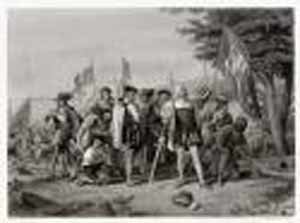
The Spaniards basically decimated the population of the Bahamas by either killing the residents, or exporting them for slavery. Very few surivied, and the Bahamas, including Eleuthera became very desolate, save for small pockets of survivors. Thus, the Bahamas were like this for the next 200 years.
The first known map of the area called Eleuthera "Cigateo", from the Arawak name, "Cigatoo". According to the time, the mapmakers changed names of the island, as seen in the following table:
| YEAR | NAME | MAPMAKER |
| 1700 | Lucayous Islands | Wells |
| 1749 | Cigateo Alebaster Lucayous Islands | Robert (Fr) |
| 1761 | Alabaster | d'Anville |
| 1784 | Harbour Island | Bowles |
| 1796 | Eleuthera Olim Ciguateo | de la Rockette |
| 1815 | Eleuthera | Wilkinson |
| 1832 | Eleuthera, Ethera Island, Cigateo, | Blair |
Aname that is very prominent in Eleuthera's history, William Sayle, is attibuted credit for naming the isle "Eleuthera", which is a variation of the Greek word for freedom. He had been Governor of Bermuda, but had fallen into disfavor with the Crown of England. Therefore, he wanted to leave Bermuda to pursue freedom, and he decided upon Eleuthera, since the Bahamas were the nearest group of islands to Bermuda. He returned to London, and petitioned Parliament to settle Eleuthera in 1654 (see page 43 for text of petition), what he envisioned as a "utopia". He promised each settler 300 acres of land, upon completion of the voyage to Eleuthera.
However, the voyage did not end smoothly; one of the two ship wrecked on the perilous north part of Eleuthera, destroying much of their supplies. He put most of the settlers ashore at Preacher's Cave, and he went to Virginia for more provisions. When he returned with more supplies, he split the group; one group went to the area now known as "The Current", and his group went to Governor's Harbor.
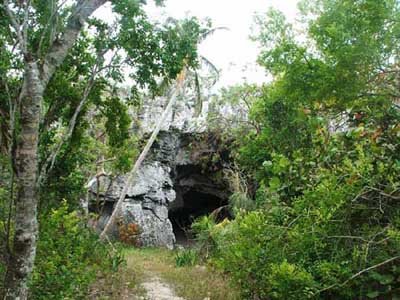
Preacher's Cave today
The soil was very rocky, and not easily cultivated, and the group continued to endure hardship. An interesting sidelight is that Governor Winthrop of Massachusetts heard of their plight, and sent supplies. In gratitude, the settlers bequeathed 7 tons of Brazilletto timber to the then-young Harvard College. In 1958, Harvard University presented to Governor's Harbor a plaque made of Braziletto wood in commemoration of that contribution, which still stands today in the Public Library.
Anyways, the settlers constructed wooden houses in Cupid's Cay, in Governor's Harbor. William Sayle returned to Bermuda, where he eventually regained favor witht the crown, and was renamed Governor of Bermuda. He sent his sons to govern Eleuthera in his stead.
The next phase of history was dominated by pirates and buccaneers. The Bahamas in general, became headquarters for the pirates, especially Nassau. The only real contact Eleuthera had with the pirates was a raid by "Calico" Jack on Harbor Island, where he burned a few fishing vessels.

Next, the English took tighter control of the islands, especially after the American War of Independence. After their defeat, many Englishmen did not want to remain in the United States. Therefore, many emigrated with their slaves to the Bahamas, causing the white population of the Bahamas to double, and the black population to triple. The British subjects were given land, to aid their start in their new country.
Next came the period of the US Civil War. This had an effect on the Bahamas after it was over, and the slaves were soon emancipated by Queen Victoria in 1834.
Various people then attempted to improve the lot of the Eleutheran islands, including a Reverend Turton. He went to Tarpon Bay, and has this to say...
"...Prior to my arrival, though the worthy magistrate had exerted himself to work a reformation, cursing, swearing, drinking to excess, Sabbath-breaking, quarrelling and every kind of wikedness prevailed. Scarcely, however, had I begun to preach to them before many received the word with all readiness of mind, and a remarkable reformation took place, evidently wrought of God..."
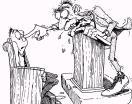
At this time, "wrecking", or the salvaging of shipwrecked boats, became a mainstay of the economy. In fact, various tricks were used to lure the ships to the reefs, in the northern part of the island. In fact, at a large reef off Spanish Wells, a reef called 'Devil's Backbone', there are many wrecks today attesting to the success of the following ruse; lanterns were put on donkeys at night, and moved to stategic areas, to fool the captains into thinking they were the lights of lighthouses, and cause the ships to go off course onto the rocks. This was especially popular in Spanish Wells, and Harbor Island. The local population even resisted the constructions of lighthouses, in the time of 1845- 1870, although more than 300 vessels had shipwrecked over the years, since "wrecking" provided a boost to the local economy.
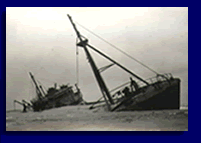
The pineapple farms then came into prominence. The pineapple has been introduced earlier, in the mid 18th century. But it was not until the turn of the century that it really became popular. The red soil of Eleuthera had been ideal for pineapples to grow. A prominent farmer, Jabez Pyfrom was a leading pineapple farmer at that time. Eleuthera's economy thrived and there was much prosperity. At one point, 40 schooners were anchored in Governor's Harbor, awaiting the harvesting of the famous pineapples (description of pineapple harvesting in 1900).
But this prosperity was not to last. The US Government started to subsidize the pineapple industries of Cuba and Hawaii, undercutting the Eleutheran crop, and this industry, as well as the economy of Eleuthera, collapsed. (For more complete story of the Pineapplye Industry in Eleuthera, go HERE)

Quarrying was then started, to try to jumpstart the economy, in the area of Hatchet Bay. George Benson, a retired English officer, was instrumental in this endeavor. He also started construction of the "cut" that is now present in Hatchet Bay, connecting the lake with the ocean.
Another man famous in the history of Eleuthera, Austin Levy, arrived in 1927, and formed the "Hatchet Bay Plantations", a combined dairy and poultry farm. He became so large, he built his own schools and stores. At about this time, Mr Arthur Vining Davis started the Rock Sound Club, as well as establishing a farm, dock, and workshops in the Rock Sound area. In fact, Princess Margaret lunched at the Rock Sound Club in 1955. Eventually, Mr. Davis sold his interests to Juan Trippe, an executive of PanAm Airlines, who converted the club into the exclusive "Cotton Bay Club", which is currently the only Robert Trent Jones designed golf course in the Bahamas.
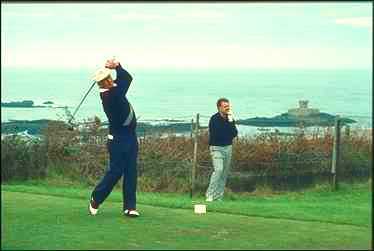
Afew women notable in this era were Charlotte Blodget and Rosita Forbes. Ms Blodget arrived in Governor's Harbor in 1937, and found much unemployment. She started a sea shell and weaving business, and established trade with Boston. Rosita Forbes, an author and journalist of minor repute, wrote copiously, and put Eleuthera on the map. She built a house, called "Unicorn Cay" on a lagoon called "Half Sound". This house is modelled on the famous "Chateaux on the Loire" in France. She said
"...if you want to live on an out-island, it is essential to forge all that you have been brought up to believe. It is odd how soon Eleuthera reduces one to a condition in which almost every happening seems easiest dealt with in a position recumbent and as distant as possible from the actual scene of disaster"
. Next, the "Two Knights" of Eleuthera came into importance, Sir George Roberts, and Sir Roland Symonette ("Pop"). Sir Robert was responsible for the development of the important, inter-island mailboat system, that is still important today, in delivering supplies, as well as the mail. Sir Roland is responsible for the roads, and a great deal of buildings in Eleuthera. He later became Premier of the Bahamas.
Other prominent Eleutherans at this time included Asa Pritchard, Sir Harold Christie (real estate), and George Baker (canning).
Around this time, Eleuthera had a bit of a scandal, involving Count Alfred de Monigny, who had built a house at the site of what was to later become 'The French Leave', and then the Club Med. It seems that the father of his bride was murdered in Nassau. He was accused but aquitted, but required to leave the Bahamas.
Due to its location near Florida, Eleuthera became a relay station between Columbia and Florida, like many other Bahamian islands, for the cocaine trade, in the late 70's and early 80's. Though not heavily involved, the island and its economy and people were definitely affected by this drug trade, which has, by and large, largely disappeared due to police activity.
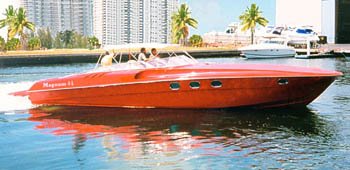
Today, Eleuthera's economy consists mostly of fishing, boating, and tourism. It is used mainly by Canadian, Italian, German, and American tourists as a vacation spot, and, for some, a temporary winter home. It is not nearly as developed as Grand Bahama (Freeport), or New Providence (Nassau).
In Eleuthera, you will find a world of sunshine, and brilliant colors, pink sand beaches, and aquamarine and azure water, where time stands till and life is leisurely and peace is a reality and not an illusion.
INTERESTING MISCELLANEOUS FACTS ABOUT ELEUTHERA
- there was a cholera epidemic in Harbor Island in 1761-1769
- there is an old cholera graveyard in Governor's Harbor
- public kissing was illegal after the nine o'clock bell was rung by the sheriff in Harbor Island in 1880
- Spanish Wells is known for having the best fishermen and spongers on the island
- the library in Governor's Harbor also serves as a court house
- most of people in Spanish Wells are descended from pirates or early settlers
- there is a severe riptide between the small island of Currant and the mainland, used frequently by divers
